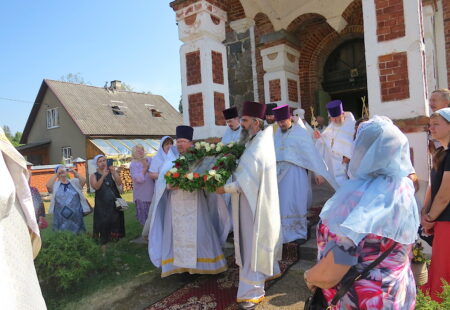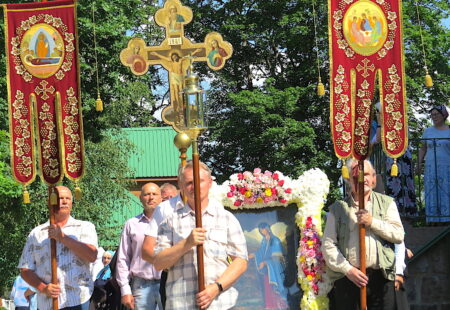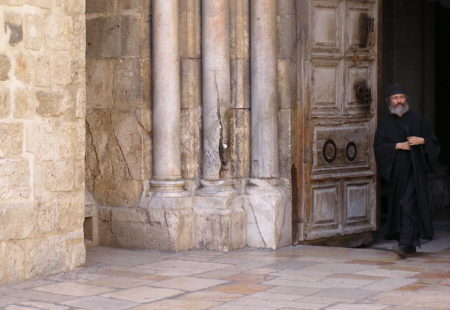Russia Holy Trinity Alexander Svirsky Monastery June 5-9, 2009
To view the photos, click on the photo and you can zoom in using the wheel or fingers on your mobile phone. Also note that under the photo there is an interface for a slideshow (the play button in the middle) and arrows for navigating through photos.
Description
The Holy Trinity Alexander Svirsky Monastery is 260 km from Saint Petersburg and 21 km from the district center of Lodeynoye Pole. The monastery founded by St. Alexander Svirsky at the end of the XV century
in the remote Olonets region, in the virgin dense forests, among the pagan indigenous population of the Korel, Veps, and Chudis, he quickly became famous. The strengthening of the Orthodox faith in this region was made possible thanks to the strict, pious ascetic lifestyle of the founder of the monastery. People began to flock here, both monks and those seeking prayerful help. Even during the life of the Monk Alexander Svirsky, the monastery was formed as a union of two settlements: at the fraternal cells — the Trinity complex, at the monastery cemetery-the Transfiguration. Both complexes today represent a single monument of architectural structures of the XVI-XIX centuries.
At the turn of the XVIII-XIX centuries, the monastery was called the “Northern Lavra”. The monastery is located in a picturesque location
on the high shore of Lake Roshchinsky, 6 km away. from the Svir River. Most of the buildings are well preserved, demonstrating the high art of the architects who built them, but all of them are in need of major restoration work today.
The oldest building of the monastery is the stone Church of the Intercession of God Mother, built by St. Alexander himself in 1533. Its construction was carried out
on the donations of Tsar Basil III. The church with a refectory and a belfry is made in the Novgorod style. Stone The Transfiguration Cathedral with the chapel of St. Alexander Svirsky (1644). Stone Cathedral of the Life-giving Church The Church of the Holy Trinity was built in 1791, but before that there was a wooden church built by the founder of the monastery, and the Church of St. Pror was consecrated in 1509. Zechariah and Elizabeth built in 1685 The Church of John of Damascus built in 1718 The Stone chapel of the Saint The Trinity Church is built on the place where, according to legend, the Most Holy Trinity appeared to the Monk Alexander of Svir.
Tsars, grand dukes, Russian emperors, noble boyars and nobles, and merchants made great contributions to the construction of churches and monastic buildings. Information about each of them was entered by the careful hand of the monks in the “Census Books”. Most of the monastery’s archive has been preserved and is housed in the National Public Library, the Library of the Russian Academy of Sciences, and the three historical archives of St. Petersburg.
During the 500-year period of the monastery’s existence, the life of the monastery outwardly did not differ much from the life of other monasteries in Russia: the heyday and fall, the invasion of enemies, fires, looting, the restoration of churches again and strict monastic life, constant prayers and work. In the best of times, the monastery had 8 churches, a rich sacristy, expensively decorated icons, a rich book depository with ancient manuscripts, scrolls and books.
Historians of the XIX century called the monastery the Northern Lavra, it was subordinated to 27 monasteries and the desert of this region. There were years when the monastery after the destruction remained only the main shrine-the relics of St. Alexander Svirsky, and a few monks (the beginning and end of the XIX century).
There was also a very dashing time (1918), when there was no shrine or monks in the monastery. The relics were taken away, the monks dispersed, some of them were shot, including the abbot-Archimandrite Eugene / Trofimov/. Instead, on the territory of the monastery: prisons, barracks, invalid homes, a state farm, a psychiatric hospital, boarded-up temples and black eye sockets of the windows of the former fraternal cells.
The new inhabitants, who settled in the monastery in 1997, had to work hard — they got the monastery ruined. The biggest event in the life of the restored monastery was the discovery of the relics of the founder of the monastery — St. Alexander Svirsky, which took place on July 30, 1998.
With His prayers and help, the ancient monastery is being revived. The churches, part of the buildings and the territory of the Transfiguration and Trinity complexes were put in order, and the liturgical life of the monastery was established.









